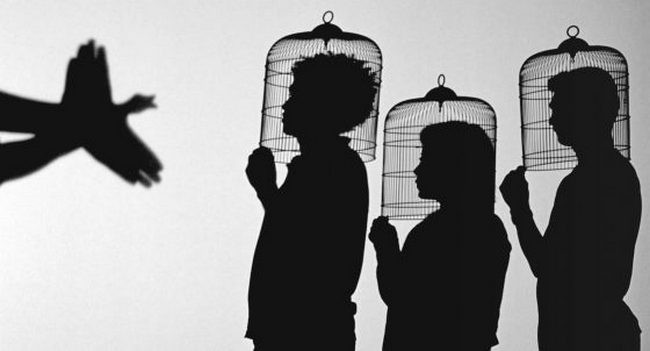Javier Téllez
Shadow Play
12 Jul - 18 Nov 2018

Javier Téllez
Shadow Play, 2014
Film installation, 35 mm film projection
10' 56''
Film still
Courtesy of the artist and Peter Kilchmann galerie, Zurich
© Javier Téllez
Shadow Play, 2014
Film installation, 35 mm film projection
10' 56''
Film still
Courtesy of the artist and Peter Kilchmann galerie, Zurich
© Javier Téllez
JAVIER TÉLLEZ
Shadow Play
12 July – 24 November 2018
Always involving excluded groups and communities in his productions, Javier Téllez (b. 1969, Valencia, Venezuela) offers his work as a vehicle for realities that challenge our canon of rationality, while at the same time reflects upon the history of the image as language and as social space, a set of norms and protocols that can sometimes be exclusive or oppressive.
In a single space, this exhibition articulates two pieces created in 2014 for the Kunsthaus Zürich. In Bourbaki Panorama, a group of refugees move in a circle inside one of the most important panoramic works in the history of European art. This great cultural monument depicts the exodus across the Alps of 87,000 French soldiers who were seeking asylum following their defeat by the Prussian troops, an event seen as the birth of Switzerland’s vocation as a haven for refugees. As they walk inside the panoramic mural, the protagonists of Téllez’s work seem to reflect on the never-ending journey of the refugee. There is also an object that is moving with them: it is Alberto Giacometti’s original bronze sculpture of 1947, The Hand, with which the artist attempted to evoke the terrible sight of an arm blown off by an explosion. The inclusion of this object, which the refugees carry with them in their circular wandering, invites a variety of interpretations both on the condition of the migrant and on the role of the artwork in our culture.
In Shadow Play, which lends its title to the exhibition, the projected shadows of the actors narrate certain scenes from their difficult, life-changing journeys. Like the panoramas of the 19th century, shadow play drama is one of the precursors of cinema, although it has also been a part of human history for many thousands of years. Through the stories told by the refugees with their hands and bodies, we gain an insight into the immemorial archetypes of exile: destruction, oppression, censorship, misery, and death. Once again, Giacometti’s Hand makes an appearance. Transformed into a performer of a concise silent drama, the sculpture’s monstrous form materializes and moves in several different scenes, thereby challenging the supposed immobility of the sculptural form. Threatening and fragile, The Hand serves as a narrative agent while at the same time its unmistakable silhouette modifies the abstraction and universality of traditional shadow play.
Shadow Play
12 July – 24 November 2018
Always involving excluded groups and communities in his productions, Javier Téllez (b. 1969, Valencia, Venezuela) offers his work as a vehicle for realities that challenge our canon of rationality, while at the same time reflects upon the history of the image as language and as social space, a set of norms and protocols that can sometimes be exclusive or oppressive.
In a single space, this exhibition articulates two pieces created in 2014 for the Kunsthaus Zürich. In Bourbaki Panorama, a group of refugees move in a circle inside one of the most important panoramic works in the history of European art. This great cultural monument depicts the exodus across the Alps of 87,000 French soldiers who were seeking asylum following their defeat by the Prussian troops, an event seen as the birth of Switzerland’s vocation as a haven for refugees. As they walk inside the panoramic mural, the protagonists of Téllez’s work seem to reflect on the never-ending journey of the refugee. There is also an object that is moving with them: it is Alberto Giacometti’s original bronze sculpture of 1947, The Hand, with which the artist attempted to evoke the terrible sight of an arm blown off by an explosion. The inclusion of this object, which the refugees carry with them in their circular wandering, invites a variety of interpretations both on the condition of the migrant and on the role of the artwork in our culture.
In Shadow Play, which lends its title to the exhibition, the projected shadows of the actors narrate certain scenes from their difficult, life-changing journeys. Like the panoramas of the 19th century, shadow play drama is one of the precursors of cinema, although it has also been a part of human history for many thousands of years. Through the stories told by the refugees with their hands and bodies, we gain an insight into the immemorial archetypes of exile: destruction, oppression, censorship, misery, and death. Once again, Giacometti’s Hand makes an appearance. Transformed into a performer of a concise silent drama, the sculpture’s monstrous form materializes and moves in several different scenes, thereby challenging the supposed immobility of the sculptural form. Threatening and fragile, The Hand serves as a narrative agent while at the same time its unmistakable silhouette modifies the abstraction and universality of traditional shadow play.
